

Steve Ratcliff is happily retired. Before this he worked for Unison and The Co-Op and was active in local politics. Despite having lived in Manchester for longer than anywhere else he still hasn’t picked up the accent and remains loyal to his boyhood football team.
Steve’s research focused on digitised materials from the archives of LGBT Humanists, particularly the collection of newsletters dating back to the group’s founding in 1979. This research also contributed to the exhibition, Picturing Nonconformity, mounted at Conway Hall in July 2024. On Bi Visibility Day, 23 September 2024, we publish his interrogation of the archives.

It’s been a pleasure and a privilege to have the chance to research the archive of LGBT Humanists.
As it’s a particular interest of mine I started by looking into the attitudes to bisexuality over the 45 years since the Gay Humanist Group started. To be honest I was expecting it to be a fairly sparse field because, as a sometime bisexual activist, I know it’s rather common in various organisations (Stonewall, for example, was late in actually starting to acknowledge bisexuals – and even later in taking up trans issues). However, I wasn’t expecting it to be as barren as it is.
Fewer than 30 items show up on the search for the word bisexual. There’s only one article about bisexuals’ lived experience. The rest is mostly passing references and overall the body of discussion of bisexuality is sparse enough that I’ve been able to review it all below.
For example The Gay Humanist Vol. 5, No. 2 lists an event: ‘Professor Bob Perks speaks on behalf of GHG to the London Bisexual Group.’ There’s no mention of what he said or of what happened at the meeting.
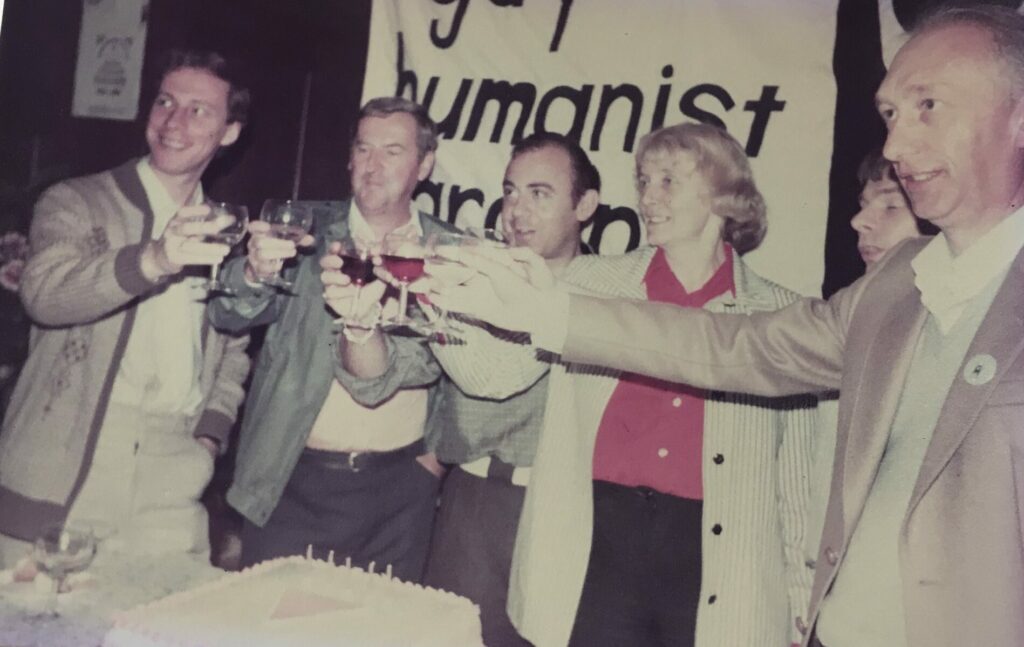
One of the fuller passing references deserves noting. In 1980, in the first Honorary President’s Address, entitled Ethics of Compassion, Maureen Duffy said:
Homosexuals are born into or fashioned in… a world whose social systems are based on the sexual, social and emotional needs of the majority who are heterosexual or bisexual (sic). It may well be true that mankind’s simple state is bisexual. However, for the species to continue a lot of hetero sex has to go on…
That point about mankind’s natural state is revisited in a couple of antagonistic articles by Peter Tatchell and Mike Foxwell in 1997/8.
He goes on to discuss Alfred Kinsey’s research in the 1940s and 50s which showed that sexuality is ‘a continuum of desires and behaviours, ranging from exclusive heterosexuality to exclusive homosexuality.’
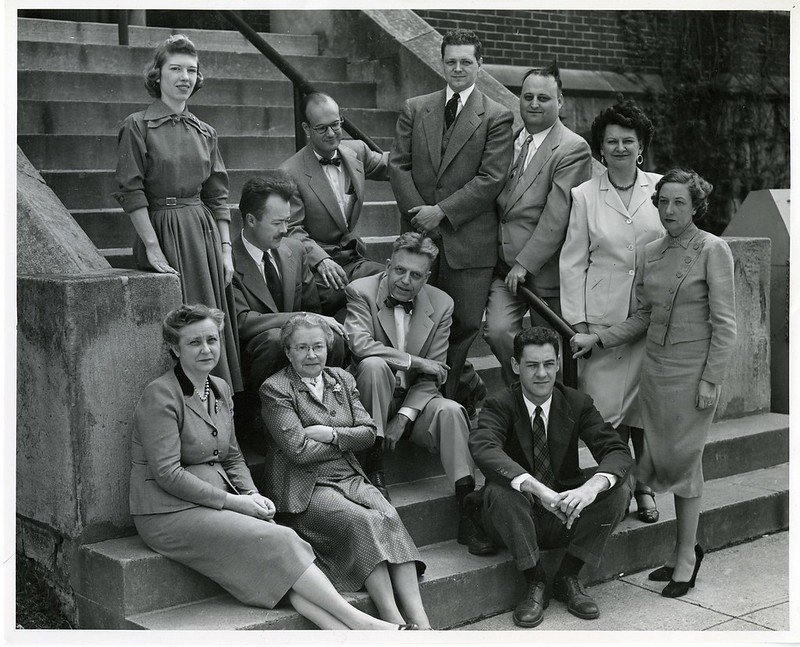
Tatchell writes that ‘It now seems fairly certain, in the light of modern research, that most people are born with a sexual desire that is, to varying degrees, capable of both heterosexual and homosexual attraction.’ He goes on to discuss Alfred Kinsey’s research in the 1940s and 50s which showed that sexuality is ‘a continuum of desires and behaviours, ranging from exclusive heterosexuality to exclusive homosexuality. A significant proportion of the population is in the middle, sharing an amalgam of same-sex and opposite-sex feelings.’
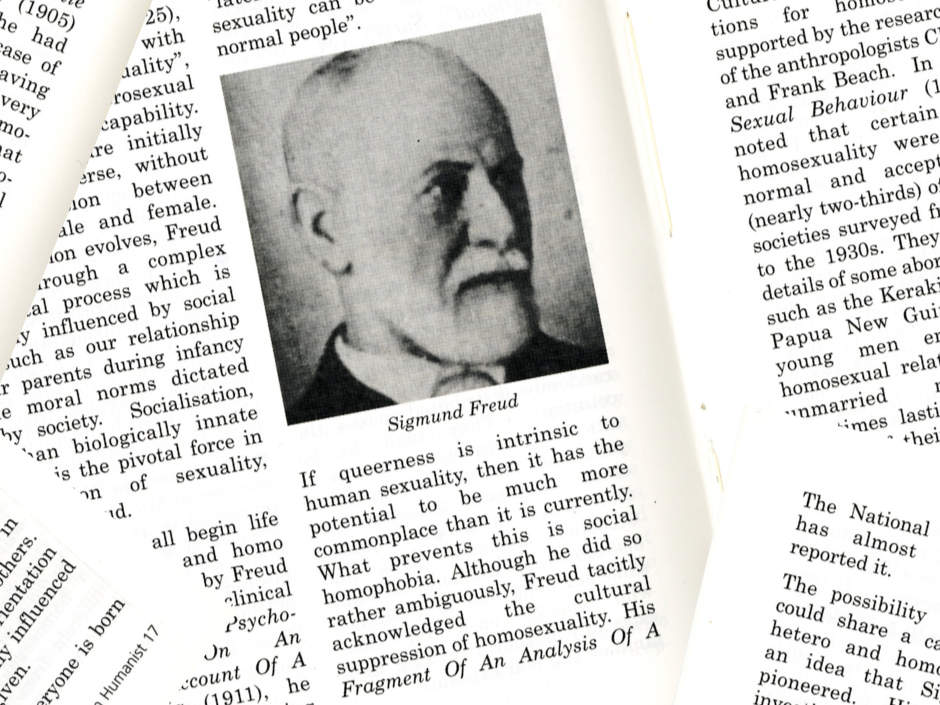
Tatchell goes on to consider Sigmund Freud’s theories on sexuality — that everyone is born with a ‘constitutional bisexuality’ which evolves mostly due to socialisation. Tatchell then states that:
The evidence from sociology, psychology and anthropology is that the incidence of heterosexuality and homosexuality is not fixed and universal and that the two sexual orientations are not exclusive. There is a good deal of overlap and movement… An individual’s sexual orientation is thus more culturally influenced than biologically given.
His article concludes that, if prejudice is vanquished, ‘The vast majority of people will be open to the possibility of both opposite-sex and same-sex relations. They won’t feel the need to label themselves (or others) as gay or straight because in a non-homophobic culture no one will give a damn about who loves, and lusts after, who.’

Now, there are some problems with the conclusions Peter Tatchell reaches and the research he relies on. The flaws in these are skewered in a response from Mike Foxwell titled ‘Bye-Bye to Bi!’.
I think Mike Foxwell does win the argument over the reliability of the evidence which forms the basis of Peter Tatchell’s arguments. However, I wonder about that exclamation mark in the title ‘Bye-Bye to Bi!’ Does Foxwell reveal his own prejudices in the opening of his article? He says in the first paragraph: ‘It seems that Mr Tatchell has a problem with the idea of exclusive homosexuality and prefers to believe in an undifferentiated, constantly oscillating bisexual libido which he would impose on us all willy-nilly.’ Well, it seems to me that if the libido is constantly oscillating neither Peter Tatchell nor anyone else will impose it, it just is. On the other hand, Mr Foxwell, if it’s not you don’t have to worry.
Foxwell’s article concludes that he shares the vision of a utopia ‘in which no one gives a damn about who loves or lusts after whom’ and that ‘we have to forget all the divisive theories and simply learn to accept and love each other as we are.’
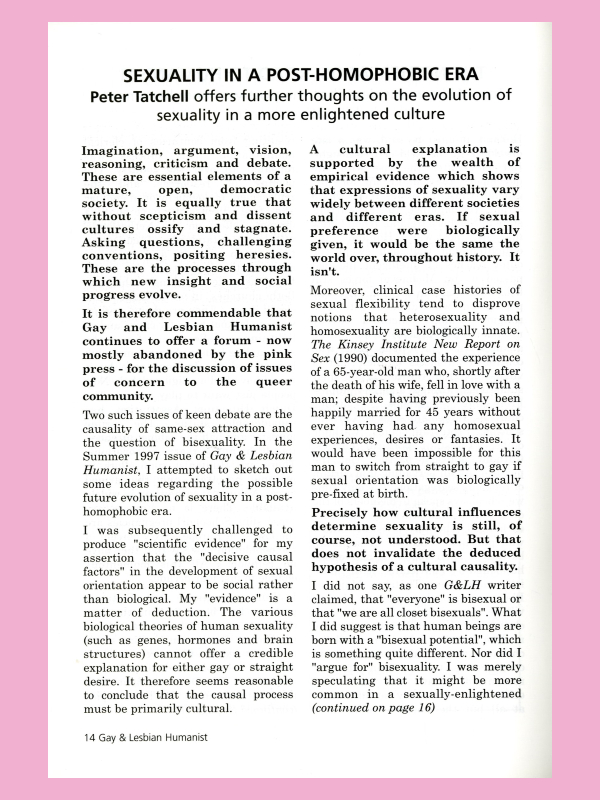
In fairness, I should add that Foxwell’s article concludes that he shares the vision of a utopia ‘in which no one gives a damn about who loves or lusts after whom’ and that ‘we have to forget all the divisive theories and simply learn to accept and love each other as we are.’ But I still wonder about the tone of the heading and that opening to the article.
Peter Tatchell replies in a later edition, seeking to clarify what he meant.
In 1997 (Vol. 17, No. 2), Diesel Balaam refers to the debate between Tatchell and Foxwell but his only reference to bisexuality is to dismiss the idea that everyone is bisexual by saying ‘Well pardon me for dissenting, but I am definitely gay. Or homosexual. Or 6 on the Kinsey scale. I don’t have a heterosexual or bisexual cell in my body.’ (That, actually, doesn’t seem to contradict the theory that social forces mould the potentially, constitutionally bisexual personality that’s in all of us into one or other orientation. However, I’m not going to go further down that rabbit hole.) Confusingly Balaam then goes on to say that he still has the occasional ‘heterosexual moment’ and that he’d ‘much rather go to bed with an attractive woman than an unattractive man.’
In the Spring 1998 issue a little note says: ‘[This debate is now ended – editor]’. And the discussion ends there for 26 years! (Until now, that is.)
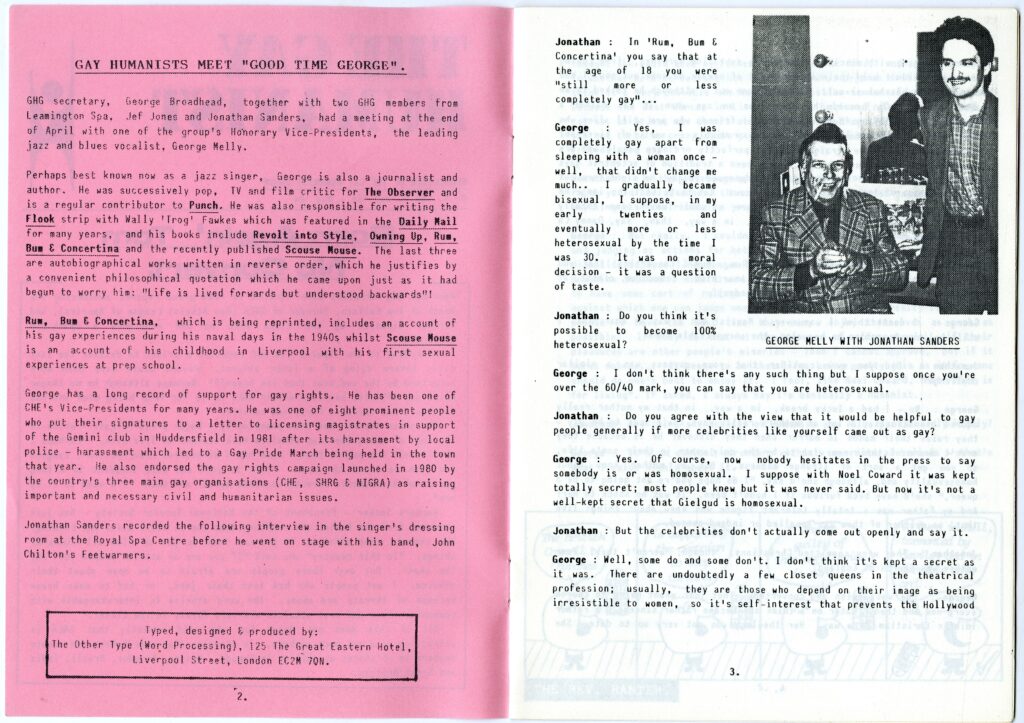
George Melly, famous jazz musician and bon viveur said in a 1984 interview with Jonathan Sanders in The Gay Humanist that at 18 he ‘was completely gay apart from sleeping with a woman once – well, that didn’t change me much… I gradually became bisexual, I suppose, by my early twenties and eventually more or less heterosexual by the time I was 30’.
Jonathan: Do you think it’s possible to become 100% heterosexual?
George: I don’t think there’s any such thing but I suppose once you’re over the 80/20 mark you can say that you’re heterosexual.

In 1988, the Gay and Lesbian Humanist published a piece by Russell Stone: a 22 year old graduate who came out as bisexual at university after having to confront his own feelings when a friend came out to him as gay. Stone writes of his Aunty, who told him: ‘One day you’ll change your mind. Because I don’t believe you ARE homosexual. I think you’re bisexual and as such it’s only going to take the right amount of pressure to tip the balance in the right direction.’ Again, we see the idea of bisexuality being a phase or a staging post, although in this case on the way to being straight – like George Melly – rather than the usual prejudice that bisexuals are gays who won’t admit it. Stone goes on to say that ‘I had my ear pierced to mark the occasion of my “coming out” as bisexual, not that every man who had his ear pierced necessarily had it done for the same reason, but that’s how it was for me’.
Interestingly, a piece below the article quotes from the British Humanist Association wedding booklet, ‘To Love and to Cherish’: ‘The way individuals express their sexuality is a matter for them alone, so long as they act with mutual love and consideration’.
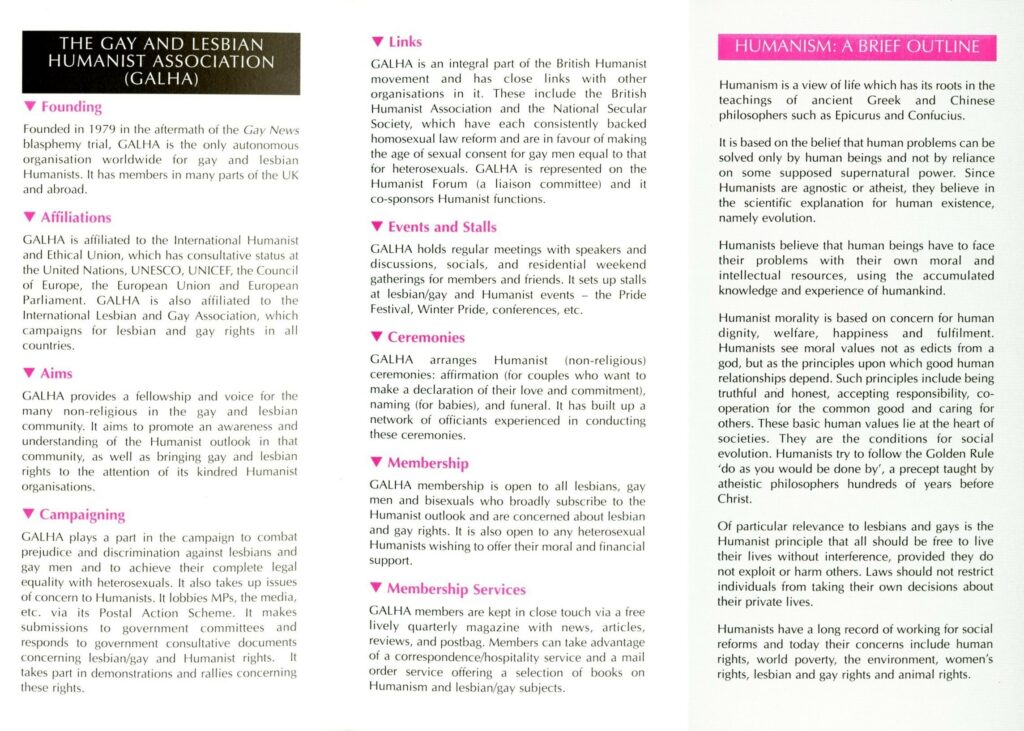
Moving forward to a leaflet from the 1990s. The parts on aims, campaigning, links and events all refer to only lesbian and gay except in the membership paragraph, where it says ‘GALHA membership is open to all lesbians, gay men and bisexuals who broadly subscribe to the Humanist outlook and are concerned about lesbian and gay rights. It is also open to any heterosexual Humanists wishing to offer their moral and financial support.’ No mention of concern about bisexual rights but bisexuals are welcome to support the lesbians and gays! Straight allies can give help and money too, note.
However, a GALHA news release dated 24 August 1995 has a footer ‘Promoting a rational humanist approach to sexuality and gay, Lesbian and bisexual rights as human rights’. (I don’t know why the word lesbian got a capital L.)
The word ‘biphobia’ only crops up once, in a recorded interview with Nick Baldwin, chair of LGBT Humanists, conducted in May 2024:
Since LGBT Humanists were founded, we have got equal marriage, we have got the Equality Act, we’ve got lots of things on the statute book. But there’s still a lot of homophobia, transphobia, biphobia out there.
Nothing comes up for the terms ‘bi erasure’ or ‘erasure’.

What do I make of this? Well, I’m happy that there’s little overt hostility towards bisexuals. But, what’s called ‘bi invisibility’ and ‘bi-erasure’ is very obvious. What’s that? One way of describing it is that bisexuals are invisible because if it’s an opposite sex couple they look straight and if it’s a same sex couple they look gay. Bi-erasure is saying that bisexuals don’t exist – or simply behaving as if they don’t.
In saying this I’m not attacking individuals, past or present. But it’s a historic, structural thing that we need to recognise before we can change it. Adding the B and the T to the name isn’t enough. What does this mean for LGBT Humanists? It means the group has to be particularly, overtly, inclusive.